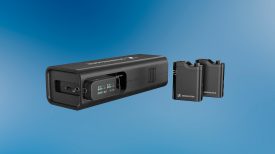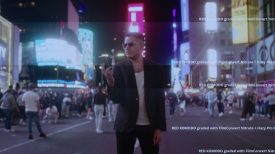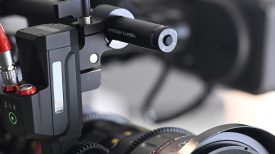It’s six am and as the sun begins to rise over the Mongolian steppes I’m standing – 5DMkII poised – wondering if this time I’ve bitten off a little more than I can chew. We’ve pitched a short film of the horse racing at the annual country wide Naadam festival to my bosses at The Guardian. As ever with the newspaper I’m on a limited budget, with the crew consisting of reporter Tania Branigan and myself; there is no second camera, sound man, assistant or producer. I usually prefer shooting solo as it allows for more intimate footage, but for this assignment I wish I had more help – I can only be in one place at one time and for a live race event like this there will be no second chances.
Getting to this point was hard enough. We arrived in Mongolia less than a day earlier so had little time to prepare. I had briefed a local fixer ahead of our arrival that I wanted to follow a young jockey through his day. But while he found a suitable child in the capital he could not find a local race where we could get sufficient access to the subjects. Luckily I’d researched online and found a possible alternative, so taking a bit of a gamble we drove half a day out of Ulan Bator to the town of Kharkhorin (a bumpy ride despite the 4×4).
Luckily the local race organisers agreed to all our requests. Our next task was to find our subject. It didn’t seem that hard given the tens of competitors, but I should have known better. With weeks to befriend one it might have been different, but every child we spoke to was incredibly shy. Tania decided it would be far to follow one of the horse trainers instead and managed to find Tsedendamba – an amazingly eloquent 61-year-old who has been in the saddle since he was four. He had a young jockey called Purevsuren who was racing the next day and we agreed to meet them just before sunrise.
I had anticipated just how hard it would be to get all the shots I wanted so I packed accordingly, bringing five HD cameras – a Canon 1DmkIV, 5DmkII, 550D and two GoPro HD cams. As I was travelling light I also chose three slower, ligher weight, f4 aperture Canon L lenses – a 17-40mm, 24-105mm and a 70-200mm. I also had a 50mm f1.2L and a Sigma 12-24mm lens which I intended to use on the 550D in cases where it ran the risk of getting damaged. Even though I only had a 20kg checked baggage allowance I also managed to bring with me a Manfrotto 561BHDV monopod, Redrockmicro shoulder rig, Zacuto Z-finder, Steadicam Merlin, Juicedlink DT454, Sanken CS-1 shotgun mic, Sennheiser G2 radio mics and a Gitzo 2941LVL tripod with Manfrotto 701HDV head…with a bit of help from Tania.
After a few hours sleep in our ger – the traditional Mongolian round, felted tents that herders live in – we headed out to the location in the dark. Tsedendamba had been up the whole night, preparing for the race, but greeted us enthusiastically. We started to interview him as the sun began to rise, as this is when herders look to the skies to predict what kind of horse will win that day.
For the extreme close up of his eyes I used a Canon EF12 extension tube on the 50mm f1.2L. Normally I would use a 100mm macro lens but I had no room for it this time. For audio I used radio mics into the Juicedlink DT454 on one channel and then a camera-mounted Sanken CS-1 shotgun mic into the other as a fallback. Thanks to the Juicedlink’s headphone monitor I was able to hear what was being fed to the camera.
For the long shots of the sunrise I fitted a Canon 2x convertor to the 70-200 f4L. The resulting f8 maximum aperture wasn’t an issue because most of these shots were quite bright and shot as a silhoutte.
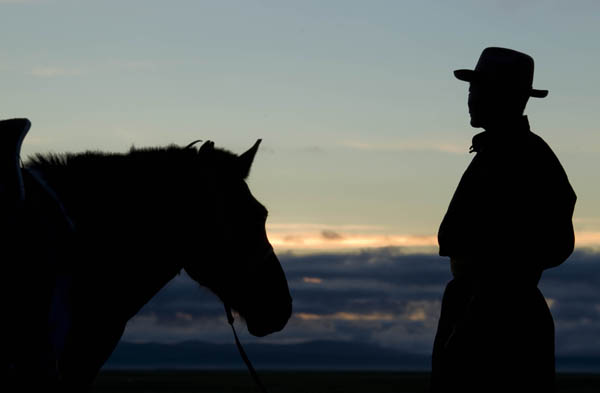
Next I fitted a 550D with the Sigma 12-24 to a Steadicam Merlin and filmed some walking shots of the boy and trainer. Even though I’ve had a little hands-on instruction with the Merlin from its inventor Garrett Brown, I still find it hard to set up and use in a hurry; hopefully my Steadicam skills will improve in time. Setting the lens aperture at f8 allowed me to set the focus at around 2 metres and get pretty much everything in focus so I wasn’t constantly trying to adjust it.
One shot I was keen to get was of the boy and trainer walking off, from a high angle. Sadly I didn’t have a Kessler Crane to hand so I had to make do. I held up in the air my 5DmkII with the 12-24mm on top of a Manfrotto video monopod, wedging the monopod’s little feet against my body. I started with it at head height next to the trainer and, as they walked off, slowly raised the camera to fake a jib effect. It’s far from perfect but I think it was worth a try. When I came to edit it I applied Final Cut Pro’s Smoothcam filter to iron out any minor bumps.
Next I had to quickly shoot a montage of shots to illustrate the festival itself. The bulk of shots were on the 70-200 f4L IS, with the new Genus Fader ND and Zacuto Z-finder fitted, using the monopod and with the lens image stabilizer to help steady the image. The focus pulls I did were all done by hand with no follow focus (again I had no room in my luggage); most were bad, but a couple came off okay. For the slow motion shots of the wrestlers I switched the camera to 720p/50 and conformed the footage to 25p afterwards in Apple’s Cinematools. I was allowed to go into the wrestling ring for only a few minutes to get the wide shots, so I had to go handheld using the 17-40mm lens on my Redrockmicro custom rig. Steadicam would have been better but was too hard to get right in the time I had. Most of the time I was just trying to avoid the wrestlers so I couldn’t really get as close as I wanted either.
For the horse race I wanted to make sure I had enough shots to allow me to cut a fast-paced sequence that showed just how intense it was. I also needed to make sure there was no additional danger to the jockeys from what I was doing – especially as there are ethical questions about whether such young children should be racing like this. I had brought a pair of GoPro HD cameras with me for this very purpose. The boy jockeys were very happy to wear them so we attached one on Purevsuren’s chest, and another on the helmet of another rider. The GoPro’s record in 1080p but have no viewfinder so setting up can be a little tricky. I guestimated the framing by looking at the reflection of the image in the lens head-on. GoPros have an amazing battery life and can record uninterrupted for long periods. This was important as I had to set the cameras running a long time before the race actually started. Unfortunately it was very dusty and one of the cameras somehow got a smudge in the lens between setting up and the race – in the end I had to use the footage as I couldn’t shoot it again.
One other downside to the GoPros is that there is no easy way to fit Neutral Density filters (apart from a small custom one, which I didn’t have, which goes inside the case). This meant that the GoPro was going to be using fast shutter speeds in the bright light of the race. Luckily this wasn’t a complete disaster as I had made the creative decision to shoot all the race footage at high shutter speed anyway for an action movie feel. I set the DSLRs at shutter speed around 1/2000th/sec when shooting the race.
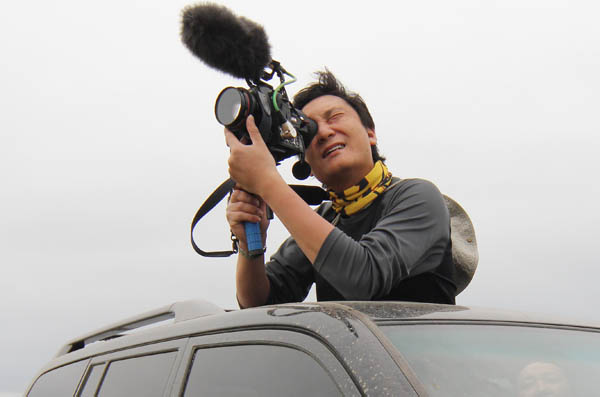
We had arranged with officials for our 4×4 to follow the race along with the other escort vehicles. For the race start I had Tania shoot a wide shot on my second camera. This worked out well as I needed both wide and long shots. I stood out of the car sunroof ready to roll. We had to maintain a safe distance so as not to frighten the horses; as a result most of the shooting was on the Canon 70-200mm with the Redrockmicro shoulder rig for support. The terrain was very rough and it was going to be impossible to get smooth shots for more than a few seconds at a time. Focussing was going to be tough too, as much as I love faster apertures I decided to shoot at around f5.6 or f8 instead so that focus was not so critical. I had also tested the Steadicam Merlin but there was no way to make it work in the high wind and with a long enough lens – I reckon the best way to do this properly would be a r/c helicopter mounted camera. I also equipped the 550D with a tripod for wide angle shots; the aim was to get ahead of the riders during parts of the race and put the camera down on its own near the track so the horses would come past it. Occasions like this are perfect for the 550D as if it were to get destroyed by a stray rider or car it would not be as bad as a dead 5DMkII.
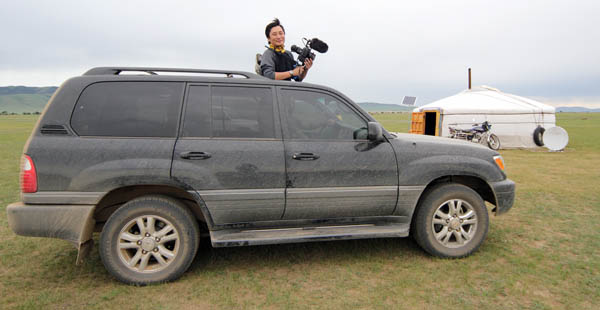
When it came down to it, the whole race took less than half an hour. I got almost enough usable footage to string together in the edit. There were a couple of shots missing however and though we were only able to follow one race all the way though I was able to pick up some b-roll from static positions on a second race later in the day.
If I were to do it again I would certainly bring a bigger crew and more equipment. That said, I hope the end result is watchable and more cinematic that one of our regular news reports. Let me know what you think.



